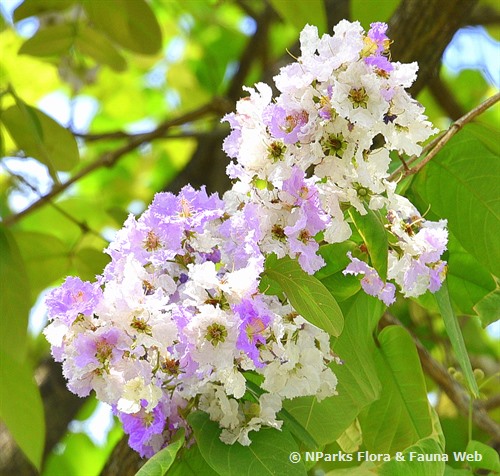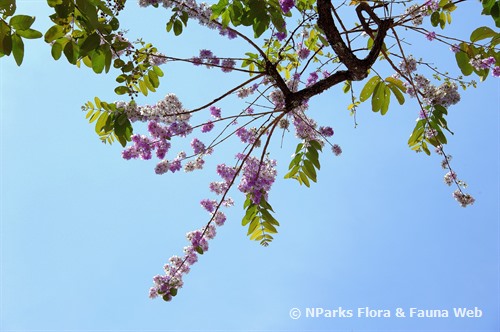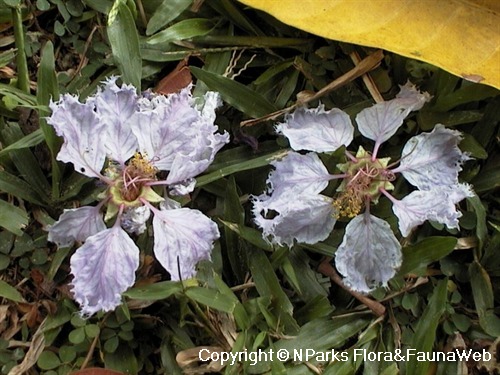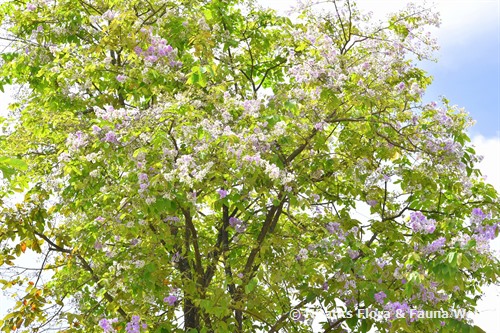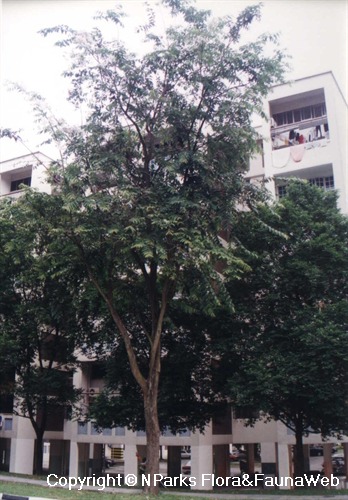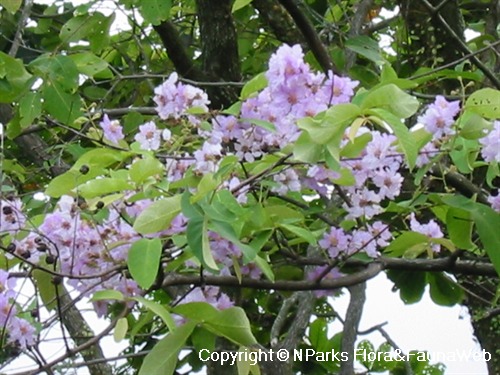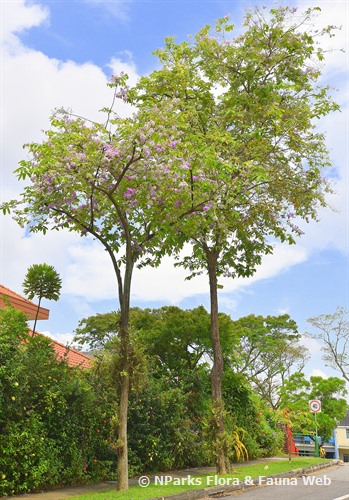
Back
Lagerstroemia loudonii Teijsm. & Binn.
| Family Name: | Lythraceae |
| Common Name: | Thai Bungor, Bungur, Burmese Bungor, Salao |
Name
Classifications and Characteristics
| Plant Division | Angiosperms (Flowering Seed Plants) |
|---|---|
| Plant Growth Form | Tree (Medium (16m-30m)) |
| Lifespan (in Singapore) | Perennial |
| Mode of Nutrition | Autotrophic |
| Maximum Height | 20 m |
Biogeography
| Native Distribution | Thailand |
|---|---|
| Native Habitat | Terrestrial |
| Preferred Climate Zone | Tropical |
| Local Conservation Status | Non-native |
Description and Ethnobotany
| Growth Form | Medium-sized tree with fissured bark, able to grow up to about 10 - 20 m tall. |
|---|---|
| Foliage | Oblong to elliptic-oblong leaves, measuring about 4 - 20 cm long and 3.5 - 8 cm wide, young leaves tend to be densely yellow tomentose, older leaves only abaxially tomentose and adaxially glabrous with a tomentulose midrib, petiole measuring about 2 - 5 mm long. |
| Flowers | Bright to pale purple flowers, cylindrical in shape, borne in terminal or axillary clusters, measuring about 8 - 20 cm wide when fully open. |
| Fruit | Fruit is a capsule, elliptic to oblong in shape, measuring about 12 - 20 mm long and 9 - 15 mm wide, surface glabrous or slightly tomentose. |
| Etymology | Genus Lagerstroemia is named after Magnus von Lagerstrom of Goteborg (1696 - 1759), friend of Linnaeus. Species loudonii is named after John Claudius Loudon (1783 - 1843) who is a Scottish gardener, architect and author of several major gardening works. |
| Ethnobotanical Uses | Cultural / Religious: Heritage Tree: There is currently one individual of Lagerstroemia loudonii listed as a Heritage Tree in Singapore. To find out more about this tree, please visit the Heritage Tree Register. |
Landscaping Features
| Desirable Plant Features | Ornamental Flowers |
|---|---|
| Landscape Uses | Parks & Gardens |
Plant Care and Propagation
| Light Preference | Full Sun |
|---|---|
| Water Preference | Moderate Water |
| Plant Growth Rate | Moderate |
| Rootzone Tolerance | Moist Soils, Well-Drained Soils, Fertile Loamy Soils |
| Propagation Method | Seed |
Foliar
| Mature Foliage Colour(s) | Green |
|---|---|
| Foliar Attachment to Stem | Petiolate |
| Foliar Apex - Tip | Acute |
| Foliar Base | Rounded / Obtuse |
| Leaf Area Index (LAI) for Green Plot Ratio | 3.0 (Tree - Intermediate Canopy) |
Non - Foliar and Storage
| Mature Bark Texture | Fissured |
|---|
Floral (Angiosperm)
| Flower Colour(s) | Pink, White |
|---|---|
| Flower Grouping | Cluster / Inflorescence |
| Flower Location | Axillary, Terminal |
Fruit, Seed and Spore
| Mature Fruit Colour(s) | Brown |
|---|---|
| Fruit Classification | Simple Fruit |
| Fruit Type | Dehiscent Dry Fruit |
Image Repository
Others
| Master ID | 1697 |
|---|---|
| Species ID | 2990 |
| Flora Disclaimer | The information in this website has been compiled from reliable sources, such as reference works on medicinal plants. It is not a substitute for medical advice or treatment and NParks does not purport to provide any medical advice. Readers should always consult his/her physician before using or consuming a plant for medicinal purposes. |


